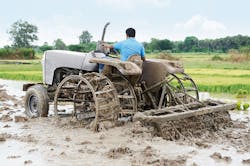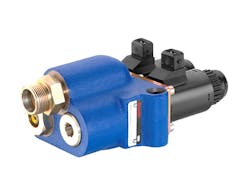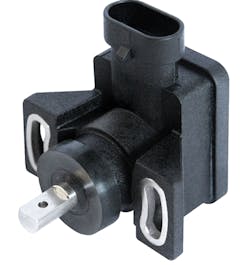Toughened-Up Hitch Control Also Drops in Price
This file type includes high resolution graphics and schematics when applicable.
Bosch Rexroth, Lohr, Germany, has had impressive results from its electrohydraulic hitch control — both in Europe and North America. Farmers have responded its precise regulation of power and position when lifting and lowering the hitch. The result is accurate tillage, so soils are turned over gently and uniformly, which improves yields.
The success of the in 2009, we decided to introduce electrohydraulic hitch control to India– an equipment market with enormous potential. But the feedback from initial test runs using tractors built by local manufacturers was not entirely satisfactory. Officials at Bosch Rexroth saw a need for the concept, but realized it had to be more rugged and considerably less expensive. Following is a report from Raman Sheshadri and Uwe Falkenhain, of Bosch Rexroth India:
Departures from Convention
When reworking the system for the Indian market, our first step was to conduct a closer analysis of the operating conditions. The tractors have to survive the most foreboding conditions: monsoons and high relative humidity, but also dryness, dust, and heat. All this is aggravated by the demands made in rice cultivation. Here, parts are sometimes submerged in packed-down mud. What’s more, the tractors usually have no sprung suspension and, as a result, transmit high shock and vibration to components. To cope with these operating conditions while also costs down for the system, we decided to modify certain components and develop others from scratch.
Two components in particular are exposed to the extreme weather conditions: an angular sensor and the control panel. Our standard control panel, designed for installation inside the operator’s cab, was not suitable for use in Indian tractors, which often lack a protective cab. So we needed a control unit that would stand up to the potentially harsh conditions without the protection of an operator cab. Plus, illumination had to be brighter because the intense sunlight typically found in India made it difficult to see the display of operating functions.
Placement was another challenge. Following extensive deliberation, the customer and we agreed to engineer an armrest ready to accept the control panel. This steadies the farmer’s hand when he presses the various buttons. We replaced the large actuator lever with a generously dimensioned switch with three positions: lift, lower, and off.
Another important consideration was service — primarily maintenance and troubleshooting. Most repair shops in India cannot run electronic fault diagnosis, so that function was incorporated into the control panel. So the control panel not only monitors operation, but also displays faults. Now the farmer can himself determine whether an electronic component is malfunctioning. To protect the entire control panel – especially the display – we fitted the unit with a tough film to keep out moisture, dust, and to resist mechanical damage.
Sealing electronics is always a challenge, and the IP-67 protection class used for the angular sensor would not withstand the extremely dusty conditions of these applications. As a result, we entirely re-engineered the sensor. Electronic components are now completely separate from the mechanical space.
We also developed the controller from the ground up. It is installed in the housing Bosch had designed for the Nano city car, manufactured by Tata Motors Ltd., Mumbai. That housing is already laid out to handle the Indian climate. The control’s software had to be adapted to the Indian market, too – shifting from the European lower linkage control to upper linkage control. This requires only one power regulation sensor instead of two and helps reduce costs.
Tackling Costs
To achieve a lower price for the Indian market, we turned to local suppliers who manufacture in India. We established local production capacities for the Bosch Rexroth’s EHR5 valve. This valve regulates hydraulic flow to the hitch cylinders, which raise and lower the hitch assembly. We also eliminated some automated manufacturing procedures. For example, the rear cover for the angular sensor cover would normally be an ultrasonically welded assembly. Instead, we to use an appropriate adhesive, thereby reducing the overall cost of the assembly.
Design options offered additional opportunities to reduce costs — material selection for example. Plastics prevalent in the Indian market are different from those typically found in Europe. In India, the strength of materials are matched to application requirements, and they are less expensive. Glass fiber reinforcement is seldom used.
In addition, we reduced the number of required parts. In the European version, an angular sensor can be programmed for various ranges of angles, depending on the geometry of the lifting system. We did away with feature for the Indian version. Instead, the opening angle is adjusted using a resistor, which is soldered in place.
Nonstop Opportunities
Our research into additional opportunities to reduce cost has not ended, even though mass production began last year. We are currently working intensively on replacing an existing power measurement sensor with a recently developed system tailored exactly to the power ranges used in India. We will be able to achieve savings on the one hand by converting from a magnetic-elastic measurement principle to a Hall-effect sensor. We’ll cut costs further by having the component — a draft pin sensor — manufactured in India.
Customizing the system has already paid off, and beyond the Indian market. This prepares us for taking the next step in other BRIC nations, where similar conditions prevail. In addition, individual components will also be of interest to European customers who can then integrate them into their overall concepts.
This file type includes high resolution graphics and schematics when applicable.
Raman Sheshadri is Sales and Industry Sector Manager, Agricultural and Forestry Machinery at Bosch Rexroth, Bangalore, India. Uwe Falkenhain is Sales and Product Manager, Mobile Electronics, for Bosch Rexroth, Schwieberdingen, Germany. For more information, call (800) 739-7684, email [email protected], or visit www.boschrexroth.com/en/us.




